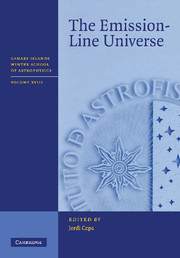Book contents
- Frontmatter
- Contents
- List of contributors
- List of participants
- Preface
- Acknowledgements
- 1 What can emission lines tell us?
- 2 The observer's perspective: Emission-line surveys
- 3 The astrophysics of early galaxy formation
- 4 Primeval galaxies
- 5 Active galactic nuclei
- 6 Chemical evolution
- 7 Galactic sources of emission lines
- 8 Narrow-band imaging
- 9 Long-slit spectroscopy
- 10 Basic principles of tunable filters
1 - What can emission lines tell us?
Published online by Cambridge University Press: 23 November 2009
- Frontmatter
- Contents
- List of contributors
- List of participants
- Preface
- Acknowledgements
- 1 What can emission lines tell us?
- 2 The observer's perspective: Emission-line surveys
- 3 The astrophysics of early galaxy formation
- 4 Primeval galaxies
- 5 Active galactic nuclei
- 6 Chemical evolution
- 7 Galactic sources of emission lines
- 8 Narrow-band imaging
- 9 Long-slit spectroscopy
- 10 Basic principles of tunable filters
Summary
Introduction
Emission lines are observed almost everywhere in the Universe, from the Earth's atmosphere (see Wyse & Gilmore 1992 for a summary) to the most-distant objects known (quasars and galaxies), on all scales and at all wavelengths, from the radio domain (e.g. Lobanov 2005) to gamma rays (e.g. Diehl et al. 2006). They provide very efficient tools to explore the Universe, measure the chemical composition of celestial bodies and determine the physical conditions prevailing in the regions where they are emitted.
The subject is extremely vast. Here, we will restrict ourselves in wavelength, being mostly concerned with the optical domain, with some excursions to the infrared and ultraviolet domains and, occasionally, to the X-ray region.
We will mainly deal with the mechanisms of line production and with the interpretation of line intensities in various astrophysical contexts. We will discuss neither quasars and Seyfert galaxies, since those are the subject of Chapter 5, nor Lyman-α galaxies, which are extensively covered in Chapter 4 of this book. However, we will discuss diagnostic diagrams used to distinguish active galaxies from other emission-line galaxies and will mention some topics linked with H Lyα. Most of our examples will be taken from recent literature on planetary nebulae, H II regions and emission-line galaxies. Emission-line stars are briefly described in Chapter 7 and a more detailed presentation is given in the book The Astrophysics of Emission Line Stars by Kogure & Leung (2007).
- Type
- Chapter
- Information
- The Emission-Line Universe , pp. 1 - 40Publisher: Cambridge University PressPrint publication year: 2008
- 4
- Cited by



